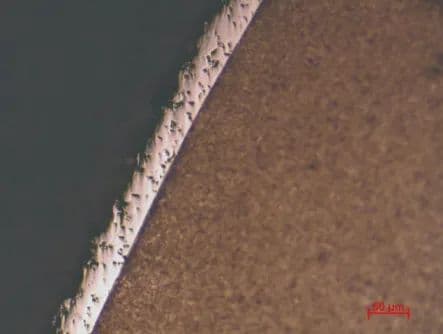1. Preface
Electroplating is a process of obtaining a relatively thin layer of other metals and alloys on the surface of some metals according to the principle of electrolysis.
It is a method of attaching a metal film to the surface of metal and other pieces of material by electrolysis.
As a traditional surface modification technology, chrome plating plays an important role in the electroplating industry.
The chrome layer can effectively protect the surface of the pin shaft and prevent excessive wear and corrosion of the chain pin shaft during actual use.
This is because chromium itself has excellent wear and corrosion resistance and strong passivation ability.
Therefore, the chrome plating process is widely used in the surface reinforcement of the chain pin shaft.
2. Chrome pin shaft processing process
Compared with ordinary heat-treated pins, chrome plating and centerless grinding after chrome plating are added to the chrome pin processing flow.
Among them, attention should be paid to the influence of pin material and pin surface quality on the coating quality, and hydrogen scavenging treatment should be carried out in time after coating.
2.1 Effect of base metal on the chrome plating layer
The good combination of chromium layer and pin shaft is closely related to the chemical properties of the pin shaft.
Some metals have passivation properties and a dense oxide film is easily formed on their surface.
If it is not activated, it is difficult to get a solid layer of chrome on the pin shaft surface.
In addition, for some pins treated by nitriding, once a layer of white compound is formed on the surface, the adhesion of chromium atoms on the surface is significantly reduced, and activation treatment is also necessary during chrome plating.
2.2 Influence of pin shaft surface quality on the chrome plating layer
First, the surface of the pin shaft must be free from pores and cracks.
This is because when there are cracks and pores on the surface of the pin shaft, when the pin shaft is coated, the electrolyte will penetrate into the gap of the pin shaft.
After a period of time, the infiltrated electrolyte will interact with the pin shaft to generate hydrogen.
If the pressure of the latter is greater than the binding force of the liner and the pin shaft, the liner will bubble and form holes, as shown in Fig.
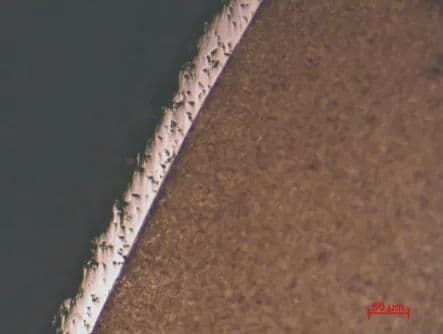
a) Bubbles in the coating
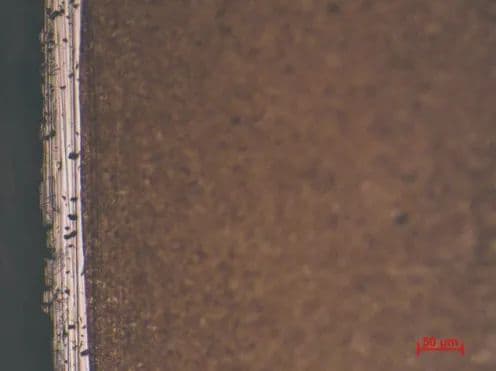
b) Plated needle eye
Fig. 1 chrome plating defects (200 ×)
Secondly, the surface roughness of the pin shaft has a great influence on the surface quality of the chrome layer, so the pin shaft is often polished or polished.
Surface roughness refers to the microspacing and irregularity of the crest and trough of waves on the surface of parts, which is greatly affected by the processing method.
However, when determining the surface roughness of the pin shaft, the pin shaft designer often neglects the influence of the surface roughness of the pin shaft on the coating effect.
Under the same thickness requirement of chrome plating, the greater the surface roughness value of the pin shaft before plating, the coarser the plating surface after plating, the greater the porosity, the more incomplete the plating, the poor adhesion between the coating and the pin shaft surface, the easier corrosion will be and the impact on service life.
When the surface roughness value of the pin shaft is too large during electroplating, the actual current density of the rough surface is smaller than the apparent current density, which will cause the potential of the rough part to not reach the potential of metal precipitation, and then there will be no plating in position.
As the roughness of the pin shaft surface decreases, the hardness of the pin shaft surface increases.
This is because the lower the surface roughness of the pin shaft, the denser the coating and the higher the hardness.
Furthermore, cracks of different degrees around the hardness indentation may also indicate the compaction of the coating, thus reflecting that the main factor affecting the hardness of the coating is the hydrogen in the electrolytic product.
The hydrogen overpotential phenomenon is different between smooth surfaces and rough surfaces, and the overpotential on rough surfaces is small.
Therefore, the hydrogen on the rough surface of the pin is easier to complete the precipitation action, and the metal ions contained therein are also less likely to be electrodeposited.
In order to ensure the service life and quality of the chrome pin shaft, the surface roughness of the pin shaft before plating should be controlled within a reasonable range.
However, appropriately increasing the surface roughness value of the pin shaft can also improve the bonding strength between the coating layer and the pin shaft.
Therefore, the surface roughness of the pin shaft should generally be less than 0.6μm.
2.3. Hydrogen scavenging treatment
Because pickling and activation treatment must be carried out in the electroplating process, hydrogen evolution and permeation are inevitable in the entire electroplating process, and hydrogen can permeate into the plating and pin metal.
Hydrogen evolution will not only reduce the performance of the coating, produce holes, marks, bubbles and other defects, but also reduce the toughness of the base pin shaft, which may lead to the fracture of chain parts in the connection state much less than than its normal failure voltage after assembly.
Therefore, the chrome pin shaft must undergo hydrogen scavenging treatment to reduce internal stress.
When the chrome pin shaft is stored, a quick and effective inspection method is needed to perform hydrogen embrittlement inspection on the product to reduce risk and quality loss.
Through the comparison test, it is suggested to adopt the bubble method.
The bubble method is simple to operate, short in time and low in cost.
Although test results do not form a unified technical requirement, they can be used as a reference to reduce the risk of hydrogen embrittlement.
It is suggested that this method be continually complemented and improved to form the company's internal control standards and even industry specifications.
The bubble method refers to heating the clean and dry pin shaft under test in paraffin (or silicone oil or petroleum jelly at a temperature of about 180°C) for 3-5min, observing the generation and escape of bubbles in the surface of the pin shaft, and judge the hydrogen content of the pin shaft under test. See Table 1.
Table 1 generation and escape of air bubbles on the surface of the pin shaft and their determination
| Generation and escape of air bubbles on the surface of the pin shaft | To determine |
| There are dense and continuous bubbles escaping from the shaft surface of the tested pin, and the duration is long (there are still bubbles escaping after heating for 3 minutes). | If the hydrogen content of the tested pin shaft is high, the pin shaft in the batch will be considered suspect or unqualified. |
| After 3 minutes, no bubbles are seen on the surface of the pin shaft. | If the measured pin shaft does not contain hydrogen or the hydrogen content is extremely low, the batch pin shaft will be considered acceptable. |
| Place the tested pin shaft into the solution heated to the specified temperature and keep it for 3 minutes. There are some bubbles, but no bubbles escape after 3 minutes. | Pin axis judgment acceptable. |
| If the pin shaft under test is not cleaned, individual bubbles will form on the pin shaft under test in the initial heating stage, or bubbles that adhere to the surface of the pin shaft under test for a long time without rising. | Invalid bubble, pin axis is considered acceptable. |
When observing and evaluating the generation and escape of bubbles on the pin shaft surface with the bubble method, the following matters should be noted.
1) The tested pin shaft should be cleaned, washed and dried with alcohol and other cleaning agents to confirm that the surface of the pin shaft is free of pollutants and dry.
2) When the light transmittance of the solution drops to less than 75% of the original solution due to impurities brought into the solution due to the long service time of the solution or the pin shaft is not cleaned, the observation will be affected.
Therefore, the solution needs to be replaced regularly.
3) This method can only evaluate whether the pin shaft contains hydrogen, but cannot evaluate the hydrogen content per unit volume.
The phenomenon of a large number of bubbles during the test does not mean that 100% hydrogen embrittlement fracture will occur, but it can be clear that the risk of hydrogen embrittlement fracture in this state is greatly increased.
Pin shafts considered suspicious or unqualified should be treated with caution.
3. Chrome pin shaft detection
3.1. Chrome layer thickness
The coating thickness is an important performance index of the pin shaft, which generally affects the corrosion resistance and wear resistance of the pin shaft.
Currently, there are many methods to detect coating thickness.
Due to the high accuracy of the metallographic method, in accordance with the requirements of GB/T 6462-2005 microscopic method for measuring the thickness of metal and oxide coatings, the coating thickness of various types of chrome pins was tested and the uniformity of the coating thickness was considered unsatisfactory (see Fig. 2).
Figure 2 shows the coating thickness of a certain type of chain pin shaft, and the difference between the thickest and thinnest parts is 0.06 mm.
It can be seen that the uniformity of coating thickness seriously affects the circularity of the pin axis.
Zhan Ruiqiu et al. showed that the internal surface stress of the chromium layer was a tensile stress.
With the increase in the thickness of the chromium layer, the internal surface tension of the chromium layer first increased, then decreased, then increased, and then decreased.
With the increase in the thickness of the chrome plating layer, the hardness of the chrome plating layer increases slightly at first, then quickly, and then slowly.
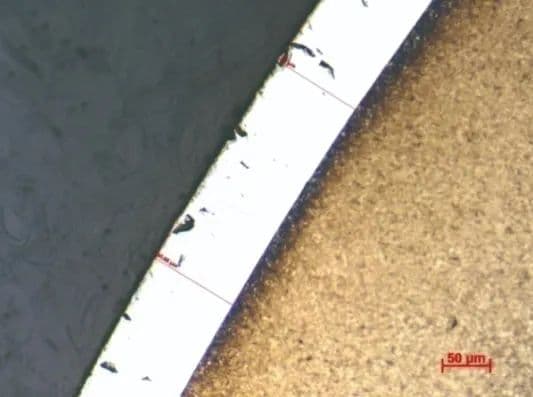
a) The thickest part of the chromium layer
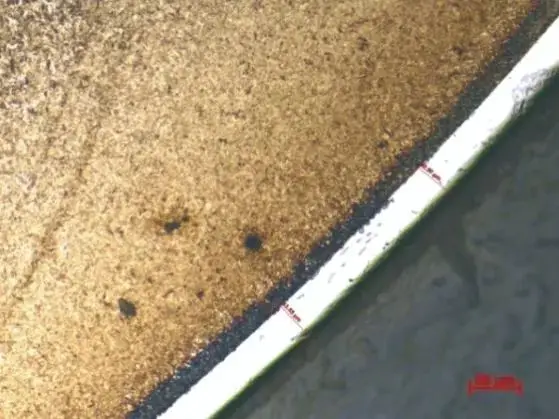
b) The thinnest part of the chrome layer
Fig. 2 Coating thickness at different positions of the chrome pin axis (200 ×)
3.2 Hardness of the chromium layer
When measuring the hardness of the chromium layer, a Vickers micro hardness tester is often used. According to the thickness of the coating, a small pressing load of 5-200g (0.049-1.96N) can be selected to make the indentation depth reach 1/10-1/7 of the coating thickness, so to ensure the accuracy of coating hardness measurement.
When the thickness of the chromium layer is more than 100μm, Rockwell hardness tester can also be used for testing.
Different hardness testers should be used for hardness testing according to part size, base material, coating thickness, indentation diameter and load size.
Therefore, the hardness value of the chromium layer varies greatly.
Table 2 shows the hardness test of the chromium layer on different types of chrome pin shafts with a load of 200g (1.96N) and a Japan Sanfeng HM-200 micro Vickers hardness tester.
It can be seen in table 2 that the maximum difference in hardness of the chrome pins of the same model is 113.7 HV.
Table 2 Chrome Pin Shaft Coating Hardness (HV)
| Model | Detection value | Average value | Difference | ||||
| A | 922.1 | 882.2 | 933.9 | 871.4 | 871.3 | 896.18 | 62.6 |
| B | 882.2 | 939.9 | 887.9 | 871.3 | 887.8 | 893.82 | 68.6 |
| W | 882.3 | 876.7 | 876.7 | 887.8 | 850.2 | 874.74 | 37.6 |
| D | 845.0 | 810.0 | 781.8 | 781.8 | 772.7 | 798.26 | 72.3 |
| AND | 904.7 | 882.2 | 819.8 | 791.0 | 834.8 | 846.50 | 113.7 |
At present, it is known that the main reason for the high hardness of the chromium layer is that a large amount of hydrogen is adsorbed on its surface.
Therefore, the pin shaft must be heat treated to remove hydrogen within 4 hours after chrome plating.
Practical demonstration shows that the total amount of hydrogen elimination is greater when the temperature is maintained at 200℃ for a suitable time.
Although the hardness is slightly reduced, the porosity and crack network of the coating will be increased, but it has little impact on the use of the chrome pin shaft.
3.3 Bonding strength of the chromium layer
The bond strength of the chromium layer is an important mechanical property of the coating.
If the bonding strength is low, it will be difficult to achieve the purpose of electroplating even if the other properties of the chromium layer are good.
In the GB/T 5270-2008 revision of test methods for adhesion strength of electrodeposited and chemically deposited metal coatings on metal substrates, the test methods for adhesion strength of electrodeposited and chemically deposited metal coatings on metal substrates are specified, but the Most of them are qualitative measurements.
At present, commonly used detection methods include steel needle scratching method, bending method, impact method and grinding wheel method.
Due to the high hardness of the chromium layer, the grinding wheel method is often used in daily detection.
Grind the chrome pin shaft on the grinding wheel until the pin shaft is exposed to the base.
If the chrome layer is not peeled off, it is qualitatively proven that the bonding strength of the chrome layer is good.
Zhang Chunhua et al. showed that the surface roughness of the substrate has a great influence on the adhesion of the coating.
By decreasing the surface roughness of the substrate, the bond strength of the chromium layer is improved.
4. Conclusion
Due to the particularity of the chrome plating process, it is easy to cause the chrome plating pin shaft to fail.
Therefore, it is necessary to strictly control the relevant processes and strengthen the detection of the chrome pin shaft to ensure that the chrome layer has good corrosion resistance, wear resistance and other properties, and thus reduce the occurrence of chain quality problems.

